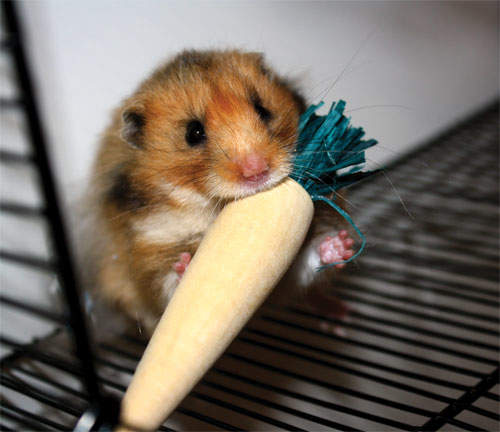If your hamster follows a healthy diet and has plenty of gnaws and chews in its enclosure, you shouldn’t have to worry about its teeth. Problems to occasionally occur, though.
Hamsters’ front teeth should be straight, free of blood, a light yellow-brown in color, with top and bottom pairs being the same length.

There are lots of different dry foods available to keep your hamster's teeth in top condition
Here are a few tips to help your hamster maintain healthy teeth:
- Provide fresh as well as dry food
Hamsters enjoy different kinds of fruits and vegetables, alongside their usual dry food. This brings variety to their diet, and is also good for their teeth. Check out our list of fresh hamster foods.
- Try different dry food options
There are many different dry foods available in stores and online, from pellets to seeds. Avoid any that have been mashed or ground, as these may cause tooth problems. By trying a few different formulae you’ll be able to see which one the hamster enjoys most. Make any changes gradually, though, as hamsters have delicate stomachs, and may get diarrhea if their diet is changed drastically in a short space of time.
- Limit shop-bought treats
Your hamster may enjoy shop-bought treats, just as kids might, but in both cases the products may not be good for the teeth! Offer them occasionally, in moderation, and always pick ones that contain no added sugar.
- Invest in a chew toy
Like all rodents, hamsters’ teeth grow throughout their lives, and can become overgrown if not worn down sufficiently. Teeth that grow too long can prevent your pet from eating properly, which is a disaster. If the teeth are overgrown, take the hamster to the vet asap.
You might not be able to tell when your hamster’s teeth are too long, so the best idea is to let your hamster deal with his dental health himself. A wooden chew toy and plenty of hard, dry food, will usually be all he needs to achieve it.
Hamster chews should be made from non-toxic wood, should not be brittle or easy-to-splinter, and must not have any paint, varnish, glue, pesticide, or other poison on them.
- Avoid human foods
Hamsters can’t eat everything humans can, so never give them meals or leftovers from your kitchen. Individual items are fine, as long as they are hamster-friendly – and not too cold (i.e. not straight from the ice box or fridge: let chilled food sit at room temperature for half an hour after being chopped up for a hamster). Take a look at our list of hamster foods to see which items are suitable.
One more thing - bacteria from your mouth can give your hamster a stomach upset, so don’t serve him food that you have bitten into. For the same reason, don’t be tempted to plant a kiss on your cute furry friend!

Comments
There are no comments just yet